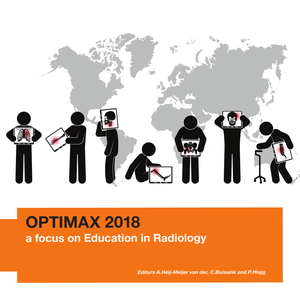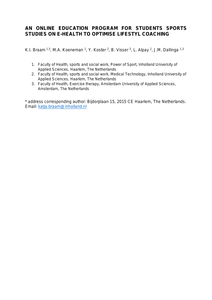This year, OPTIMAX was warmly welcomed by University College Dublin. For the sixth time students and teachers from Europe, South Africa, South America and Canada have come together enthusiastically to do research in the Radiography domain. As in previous years, there were several research groups consisting of PhD-, MSc- and BSc students and tutors from the OPTIMAX partner Universities or on invitation by partner Universities. OPTIMAX 2018 was partly funded by the partner Universities and partly by the participants.
DOCUMENT

The “Creating Age-friendly Communities: Housing and Technology” publication presents contemporary, innovative, and insightful narratives, debates, and frameworks based on an international collection of papers from scholars spanning the fields of gerontology, social sciences, architecture, computer science, and gerontechnology. This extensive collection of papers aims to move the narrative and debates forward in this interdisciplinary field of age-friendly cities and communities. (This book is a reprint of the Special Issue Creating Age-friendly Communities: Housing and Technology that was published in Healthcare)
MULTIFILE
![Creating age-friendly communities: Housing and technology [book]](https://publinova-harvester-content-prod.s3.amazonaws.com/thumbnails/files/previews/pdf/20250506132407955076.b97102b7-5bdc-4b75-a293-4281df36ef73-thumbnail-400x300.png)
DOCUMENT
De bibliotheekfunctie gaat zich uitbreiden voorbij het boek.
DOCUMENT
Process Mining can roughly be defined as a data-driven approach to process management. The basic idea of process mining is to automatically distill and to visualize business processes using event logs from company IT-systems (e.g. ERP, WMS, CRM etc.) to identify specific areas for improvement at an operational level. An event log can be described as a database entry that signifies a specific action in a software application at a specific time. Simple examples of these actions are customer order entries, scanning an item in a warehouse, and registration of a patient for a hospital check-up.Process mining has gained popularity in the logistics domain in recent years because of three main reasons. Firstly, the logistics IT-systems' large and exponentially growing amounts of event data are being stored and provide detailed information on the history of logistics processes. Secondly, to outperform competitors, most organizations are searching for (new) ways to improve their logistics processes such as reducing costs and lead time. Thirdly, since the 1970s, the power of computers has grown at an astonishing rate. As such, the use of advance algorithms for business purposes, which requires a certain amount of computational power, have become more accessible.Before diving into Process Mining, this course will first discuss some basic concepts, theories, and methods regarding the visualization and improvement of business processes.
MULTIFILE
This book is about you. Are you, as a customer, as an entrepreneur, as an individual, ready for the Internet and e-business? Do you see the possibilities and do you actually use these? Do you have an idea of where it will end? Did you ever list how the Internet changes your life as an entrepreneur? And, do you make the next move or do you let it all happen to you? About the fact that the Internet is much more than e-mail, shopping, chatting and searching. About how the Internet as a driver of e-business changes the set-up of your company or educational institution and maybe your very business in a very positive and still “e-secure” way: marketing & sales, operations, purchasing, recruitment & selection, e-HRM. We go through six related trends with you, without pretending to be complete.
DOCUMENT

In dit abstract wordt de ontwikkeling van een online onderwijsmodule beschreven gericht op eHealth voor leefstijlverbetering
MULTIFILE

Prof. N. Douben van de TU/e heeft een boek gepubliceerd met de titel "Solidaire Economie". Mijn eerder verschenen E-book had dezelfde titel. De papieren versie verschijnt echter pas in de loop van 2016. Inhoudelijk zijn er echter grote verschillen.
LINK
The authors compared three methods of reading and learning by using paper, as well as a variety of interactive study forms. Thier work is part of the large Amsterdam E-Boekenstad (E-Book city) research project (www.e-boekenstad.nl and http://e-boekenstad.wikispaces.com/). They investigate to what extent the materiality of a book determines the usability of the book form. Their tests were conducted in 2010 and 2011. They compared; 1.learning from paper, a laptop and an e-ink e-reader 2.paper with reading from web pages 3.paper and material presented into a digital mind map. As it turns out, in a study situation, electronic reading can only beat reading from paper when it offers real added value. For example, by providing a better overview and shorter comprehensive texts, like they did in their second study. The most important conclusion from all tests is that a simple translation from paper format to electronic format is not enough. Publishers should take advantage of the possibilities new techniques offer, and perhaps discard ‘traditional thinking’ in terms of linear essay-type books and paragraphs.
DOCUMENT

DOCUMENT